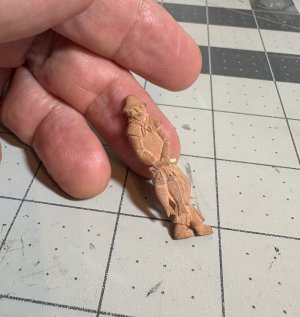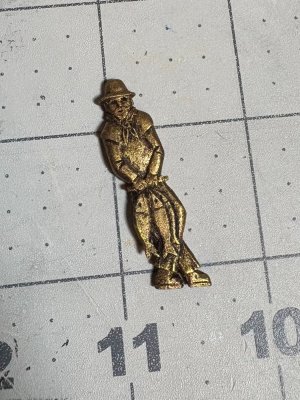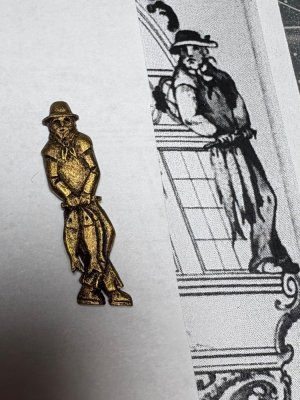-

Win a Free Custom Engraved Brass Coin!!!
As a way to introduce our brass coins to the community, we will raffle off a free coin during the month of August. Follow link ABOVE for instructions for entering.
You are using an out of date browser. It may not display this or other websites correctly.
You should upgrade or use an alternative browser.
You should upgrade or use an alternative browser.
Tutorial An easy introduction to making wood ornaments by Stephan Kertész (Steef66)
Great job Jimsky!This is my most recent effort. While I may not have fully captured his menacing expression, I strived to convey the feeling.
View attachment 517493
- Joined
- Aug 8, 2019
- Messages
- 5,486
- Points
- 738

The eyes are wild, which worked out well, as did the helmet and horns. The moustache is too happy making the expression as a whole too happy but it looks good. You can adjust it to point it downwards along the mouth and chin by putting some relief in the beard there. On the side between the eyes and mouth, make it a bit narrower and let the hair come out a bit higher under the helmet. I think this will improve the proportion a little. You can then make the cheekbones a little sharper and deeper. This would make the look more powerful. Don't do anything else to the mouth. The lower lip is perfect, as is the nose.This is my most recent effort. While I may not have fully captured his menacing expression, I strived to convey the feeling.
You're doing really well Jim. I can see the fun you're having.
High gent great explosion of creativity here. Keep it coming.
Hello everyone! Following Maarten's suggestion, I wanted to share some of my latest attempts at carving. I'm currently focused on the challenge of creating realistic eyes. While carving the nose wasn't the primary goal, I found it surprisingly helpful in establishing the correct placement and relationship between the eyes. I'm at a point where I'd really value some constructive criticism on these pieces. While my admiral kindly tells me they're 'beautiful' (and yes, I appreciate the sentiment!  ), what I truly need are your keen eyes to point out any areas for improvement. My aim is to learn from any mistakes and avoid them in future carving exercises. I anticipate many more eyes will emerge from my workbench before I move on to incorporating other facial features. So, please, don't hesitate to share your thoughts and identify any aspects I could refine. Your insights would be incredibly helpful!
), what I truly need are your keen eyes to point out any areas for improvement. My aim is to learn from any mistakes and avoid them in future carving exercises. I anticipate many more eyes will emerge from my workbench before I move on to incorporating other facial features. So, please, don't hesitate to share your thoughts and identify any aspects I could refine. Your insights would be incredibly helpful!
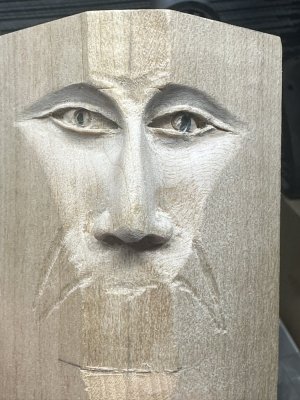
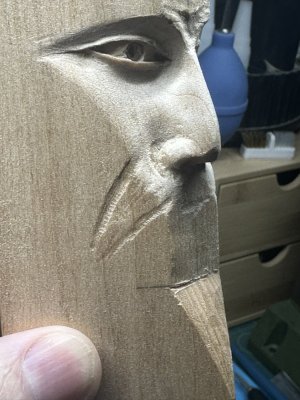
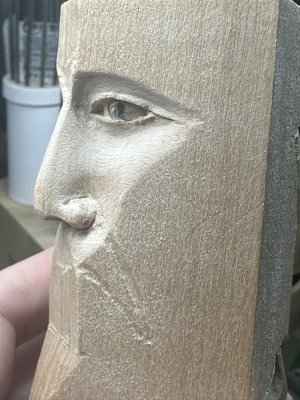



- Joined
- Aug 8, 2019
- Messages
- 5,486
- Points
- 738

There was a guy on YouTube that did carving like this and he got a few video's about carving eyes, noose and mouth. I try to find them back. He gave a good discription how to handle this. But you're on the right track. Like the noose and eyes. But remember this is different to carving or rotary carving on a small scale. Still a good way to proof your skills.
Back to your carving. Looking to the front and the eyes, it seems that there is something out of proportion. Can't put a finger on it. It looks good but on the other hand.......
Back to your carving. Looking to the front and the eyes, it seems that there is something out of proportion. Can't put a finger on it. It looks good but on the other hand.......
Thos already looks great Jim. I think the eyes are placed to close to each other and the nose is to long but you are certainly getting there.
There are many talented sculptors and wood carvers sharing their work on YouTube, but the artist who has truly impressed me is Alec LaCasse. He specializes in relief carving and offers an excellent 10–15-minute beginner series where he teaches how to carve various facial features. It's worth noting that LaCasse doesn't use rotary tools in his demonstrations, so as I follow along and learn, I’ve had to adapt by incorporating rotary bits into my own process. Regarding the carving itself, I really appreciated your feedback; I can see the differences in the eyes when I examine them individually, but when I look at both together, the contrast isn’t quite as obvious to me.There was a guy on YouTube that did carving like this and he got a few video's about carving eyes, noose and mouth. I try to find them back. He gave a good discription how to handle this. But you're on the right track. Like the noose and eyes. But remember this is different to carving or rotary carving on a small scale. Still a good way to proof your skills.
Back to your carving. Looking to the front and the eyes, it seems that there is something out of proportion. Can't put a finger on it. It looks good but on the other hand.......
While I practice, my goal isn’t to become a professional carver, I simply want to learn how to represent different parts of the human and animal bodies in wood with clarity and expression. I'm especially interested in understanding the "game of shadow," where the careful use of light and shadow brings a carving to life. Something is fascinating about how the right depth or curve can suggest movement, emotion, or form purely through shadow. I really enjoy this process! Thanks again for starting this thread and giving us the foundational guidance; it’s been both helpful and inspiring.
Yeah, proportions aren’t the only thing I’m struggling with - thanks for pointing that out. Every feature has its own challenge, and I’m finding that ears, noses, and especially eyes each require a different kind of attention and technique. There will definitely be many more eyes and noses carved before I even think about attempting something as ambitious as a full figurehead. And who knows, maybe I’ll never truly become a carver in the traditional sense, but that’s okay. For me, it’s more about the process of learning and discovering what I can do with wood, light, shadow. and a rotary tool.Thos already looks great Jim. I think the eyes are placed to close to each other and the nose is to long but you are certainly getting there.
- Joined
- Aug 8, 2019
- Messages
- 5,486
- Points
- 738

That’s the one I ment. I recognized the carved bushman head with beard and knitted beanie. He explains everything very slow and simple. I wish I could practise carving, but my hands don't allow.Alec LaCasse
But I understand your practise of shadows. That's a good one to mentioning. Because that is important when you make tiny figures. You cant make details in all cases because to small, but you can make depth and illusion by shadows in the wood.
Difficult, when I make a face of half a cm. in diameter, sometimes I got it right. And then I move the drill over a place by scratching a tiny amount of wood away. The effect of the shadow is gone. The face changes complete. You have to learn how to avoid that. Still learning on that. The vikinghead was easy, it was "big". The mongol head was a more difficult, much smaller.
I'm working now on the sails (not much) and on the rope-walk. But seeing you here to start rotary carving is knockin on the door.
Last edited:
Looks very lifelike. Beautifully done!!While carving the nose wasn't the primary goal, I found it surprisingly helpful in establishing the correct placement and relationship between the eyes.
Assuming the picture in post #82 is a Viking helmet, did they really have horns on them? There were certainly horned helmets discovered during the Bronze Age long before the Vikings, and I know this is sometimes depicted on Viking helmets today, but...........
Interesting little article from the Smithsonian: https://www.smithsonianmag.com/smar...ed-helmets-actually-3000-years-old-180979339/
The horns do make it more menacing
Allan
Thanks, Allan. Lifelike was the target of this practice.Looks very lifelike. Beautifully done!!
Assuming the picture in post #82 is a Viking helmet, did they really have horns on them? There were certainly horned helmets discovered during the Bronze Age long before the Vikings, and I know this is sometimes depicted on Viking helmets today, but...........
Interesting little article from the Smithsonian: https://www.smithsonianmag.com/smar...ed-helmets-actually-3000-years-old-180979339/
The horns do make it more menacing
Allan
You're absolutely right to question the horned helmet idea—it’s one of those persistent myths that keeps showing up in pop culture but doesn't hold up to historical evidence. Viking helmets with horns just weren’t a thing in their time. The classic image actually comes from 19th-century Romanticism and opera costumes, especially Wagner’s Ring Cycle. As for the real deal, the only surviving example of a Viking-age helmet (the Gjermundbu helmet from Norway) has no horns, just a rounded cap with a nose guard. There were horned helmets in the Bronze Age, like the Viksø helmets from Denmark, but those are over a thousand years earlier and likely ceremonial.
If you're going for authenticity in your carving or model, a no-horn helmet is the way to go, but I totally get the temptation to include them. They do look dramatic and add complexity to the carving process.
- Joined
- Oct 9, 2020
- Messages
- 2,198
- Points
- 488

wow. it looks like metal. Very impressiveSemi finished figure…
View attachment 517105
And painted…black base coat and dry brushed gold to maintain my current ships theme…
View attachment 517106
Next to reference material…
View attachment 517107
This took me two days and was mostly carved with my xacto knife and mini palm chisel. It’s not perfect, but I can live with it.
... continue practicing a part of a study of human faces; aim for expressive, confident, and precise eyes (for now). I want to get a good eye for the eyes. 

Critiques and suggestions for improvement (tweaking) are welcome and strongly encouraged! As for my personal view, I already spotted that the lower eyelid edge transition between the lower eyelid and the cheek plane could use a bit more subtle rounding. Right now, it’s a touch abrupt, which slightly flattens that area visually. The eyebrow area might benefit from a tiny bit more mass toward the upper outside corner to round out the brow's natural arch, adding that subtle curve might enhance realism. But I have not concentrated on the eyebrow area much. Now, what do you think?

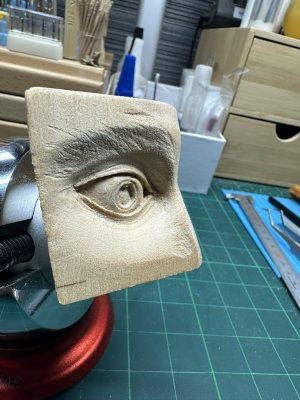
Critiques and suggestions for improvement (tweaking) are welcome and strongly encouraged! As for my personal view, I already spotted that the lower eyelid edge transition between the lower eyelid and the cheek plane could use a bit more subtle rounding. Right now, it’s a touch abrupt, which slightly flattens that area visually. The eyebrow area might benefit from a tiny bit more mass toward the upper outside corner to round out the brow's natural arch, adding that subtle curve might enhance realism. But I have not concentrated on the eyebrow area much. Now, what do you think?


Thank you, my friend, Mirek. Each person carries hidden talents lying dormant within them. Sometimes, all it takes is the right spark to awaken them.Witaj
Kolejny wielki talent, podziwiam Jimski . Pozdrawiam Mirek
Do you see areas for improvement? What do you like, and what don't you?
Dziękuję, mój przyjacielu, Mirku. Każda osoba nosi w sobie ukryte talenty, które drzemią w niej. Czasami wystarczy odpowiednia iskra, aby je obudzić. Czy widzisz obszary do poprawy? Co ci się podoba, a co nie?
- Joined
- Dec 9, 2019
- Messages
- 945
- Points
- 403

Pięknie to wygląda Jimski zachowane proporcje jestem pod wrażeniem . Pozdrawiam MirekCześć wszystkim! Zgodnie z sugestią Maartena, chciałem podzielić się kilkoma moimi najnowszymi próbami rzeźbienia. Obecnie skupiam się na wyzwaniu stworzenia realistycznych oczu. Chociaż rzeźbienie nosa nie było głównym celem, okazało się to zaskakująco pomocne w ustaleniu prawidłowego umiejscowienia i relacji między oczami. Jestem w punkcie, w którym naprawdę doceniłbym konstruktywną krytykę tych dzieł. Podczas gdy mój admirał uprzejmie mówi mi, że są „piękne” (i tak, doceniam to uczucie!), to czego naprawdę potrzebuję to wasze bystre oczy, aby wskazać wszelkie obszary do poprawy. Moim celem jest wyciągnięcie wniosków z wszelkich błędów i unikanie ich w przyszłych ćwiczeniach rzeźbienia. Przewiduję, że wiele więcej oczu wyłoni się z mojego warsztatu, zanim przejdę do włączania innych cech twarzy. Więc proszę, nie wahaj się podzielić swoimi przemyśleniami i wskazać wszelkie aspekty, które mógłbym dopracować. Twoje spostrzeżenia byłyby niesamowicie pomocne!
View attachment 519957
View attachment 519958
View attachment 519959
Thank you for your feedback, mon ami. The little spire is there, it is in the shadow of the light.Nice carving. The only thing I see or don't see is the little spieren like thing in the eye by the noose where the upper lid comes together with the under lid. For the rest you did a good job. Like the way you carved the iris.

